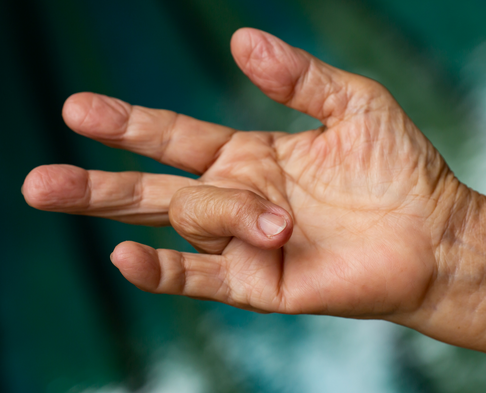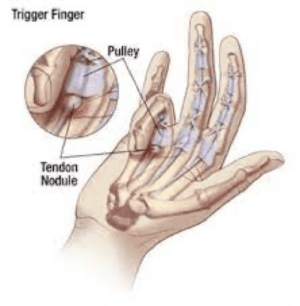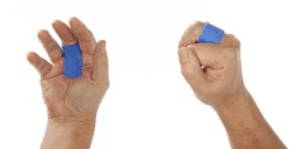
What Is Trigger Finger?
Have you ever experienced one of your fingers getting stuck in a bent position? Felt or heard a snap when you tried to straighten them? You most probably suffer from a trigger finger. It occurs mostly in the ring finger and thumb. In severe cases, the trigger finger can get locked in a bent position. It causes pain and swelling, and you might be able to feel a lump at the base of your finger. The affected finger is often stiff and difficult to move in the morning. This “locking” of your fingers makes everyday tasks like holding onto a mug and typing difficult and awkward.
For our fingers to glide freely between making a fist(flexion) and being fully straight(extension), it uses a rope-like system with tendons that run underneath several “pulleys” to keep it close to the bone and in your palm. This pulley systems comprise of five annular pulleys (A1-A5) and three cruciform pulleys (C1-C3). A trigger finger occurs when the tendon that bends your finger has trouble fitting through the pulley. You can usually feel a small lump as your tendon move up and down when you bend your finger. The A1 pulley is most often affected.

Who Is Most Likely To Get Trigger Finger?
You are more likely to develop a trigger finger if you are between the ages of 40 and 60. Women are also six times more likely to develop it than men.
Why Do You Get A Trigger Finger?
Evidence is limited on why someone would develop a trigger finger.
Keeping that in mind, it has been suggested that certain occupations and hobbies that require prolonged forceful finger flexion might contribute to the cause. Strenuous grasping of small tools or objects with sharp edges in farmers, industrial workers, and musicians, carrying shopping bags, prolonged writing, and rock climbing are all possible culprits.
Trigger fingers can also develop secondary to other pathologies such as Carpal Tunnel Syndrome, De Quervain’s tenosynovitis, Hypothyroidism, Rheumatoid Arthritis, and diabetes. Your chance of developing a trigger finger is 2-3%, but if you have diabetes, your chances increase to 10%.
It is essential to note that the trigger finger’s cause is often multi-factorial.
How Can I Treat My Trigger Finger?
Trigger finger treatment usually starts conservatively, particularly if it is uncomplicated, and your symptoms have only been present for a short time. This is where your Hand Therapist/Occupational Therapist can make a significant impact before the need for surgical intervention. A valid prescription/referral from a physician or nurse practitioner is all we need in New York state to get started.
Hand Therapy/Occupational Therapy
Here are some of the treatment interventions you can expect when you see your occupational therapist:
Patient Education
Your therapist will take the time to educate you on anatomy, pathology, and treatment options. Information on rest, modification of activities, specialized tools, and posture will also be included.
Splinting
A removable custom finger splint will limit the movement in your finger to allow the tendon to rest and for inflammation to reduce.

Edema Management For Trigger Finger
To reduce the swelling, we might use gentle wrapping, retrograde massage, and hot/cold treatment to push the swelling away.
Manual Therapy
To maintain the range of motion in all your joints, your therapist will isolate your finger joints one by one to prevent “locking”, but still maintain full range.
Pain Management
Your therapist has multiple “tricks” to manage your pain without medication.
Strengthening Program
To avoid loss of strength due to pain and “locking,” your therapist has therapeutic putty, elastic bands, marbles, squeezy balls, and plenty more to maintain your strength while protecting your affected finger.
Ergonomics
Your therapist will assess essential tasks affected by your trigger finger and suggest how to make changes and/or use different assistive devices to avoid pain and discomfort. This way you can still do the activities important to you.
Home exercises
A home exercise program will ensure that you can continue with the treatment plan with confidence and clear instructions.
Medication And Steroid Injection
If symptoms continue, anti-inflammatory medications, such as ibuprofen, may be prescribed or steroid injection(s) may be considered. A steroid injection is inexpensive, easily performed, and less invasive than surgery. Delivery of steroids into the tendon sheath is vital for its effectiveness. A steroid injection may be helpful in many patients, although recurrence of symptoms can occur.
Patients with prolonged symptoms are less likely to have a resolution.
Surgical Intervention
Surgery may be required if the condition does not respond to non-surgical treatments or continues to recur. The surgery is done under local anesthesia and does not require a hospital stay.
During the surgery, a tiny cut is made in the sheath through which the tendons pass. This allows the tendon to slide more easily through the sheath. The surgery helps restore the affected finger(s) or thumb’s ability to bend and straighten without pain or stiffness.
Recovery time following surgery is typically only a couple of weeks.
Susanne Corrales OTR/L is an Occupational Therapist and Owner of Hand Wellness OT in Long Island, NY. Her area of practice is Upper Extremity Musculoskeletal Orthopedics and Hand Therapy. You can e-mail her at susanne@handwellnessOT.com or call her on (516) 472-0873 to schedule your appointment.
REFERENCES:
Bonnici AV, Spencer JD. A survey of ‘trigger finger’ in adults. J Hand Surg [Br] 1988;13:202–3.
Gorsche R, Wiley JP, Renger R, et al. Prevalence and incidence of stenosing flexor tenosynovitis (trigger finger) in a meat-packing plant. J Occup Environ Med. 1998;40:556–60. doi: 10.1097/00043764-199806000-00008.
Makkouk AH, Oetgen ME, Swigart CR, Dodds SD. Trigger finger: etiology, evaluation, and treatment. Current Reviews in Musculoskeletal Medicine. 2008 Jun 1;1(2):92-6.
Andreu JL, Oton T, Silvia-Fernandez L, Sanz J. Hand pain other than carpal tunnel syndrome (CTS): The role of occupational factors. Best Practice and Research Clinical Rheumatology. 2011;25:31–42.
Schöffl VR, Schöffl I. Finger pain in rock climbers: reaching the right differential diagnosis and therapy. J Sports Med Phys Fitness. 2007;47:70-78.
Colbourn J, Heath N, Manary S, Pacifico D. Effectiveness of splinting for the treatment of trigger finger. Journal of Hand Therapy.2008; 21(4):36-343.
Matthews A, Smith K, Read L, Nicholas J, Schmidt E. Trigger finger: An overview of the treatment options. Journal of the American Academy of PAs. 2019 Jan 1;32(1):17-21.
Peters-Veluthamaningal C, Winters JC, Groenier KH et al. Corticosteroid injections effective for trigger finger in adults in general practice: a double-blinded randomised placebo controlled trial. Annals of the Rheumatic Diseases. 2008;67;1262-1266.
